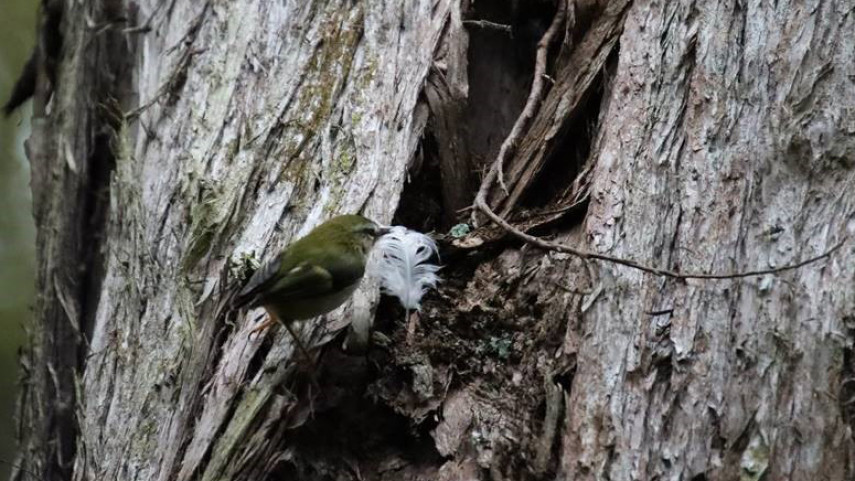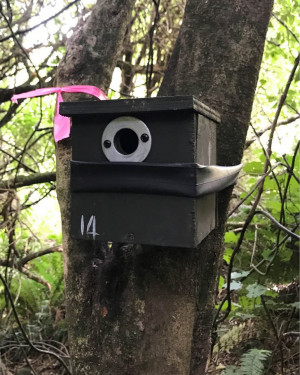
Tiny homes for tiny birds on Banks Peninsula

Share this story
The titipounamu/rifleman on Te Pātaka o Rākaihautū/Banks Peninsula are getting some new accommodation to help improve their chances of breeding successfully.
Native to New Zealand, titipounamu (Acanthisitta chloris) are the country’s smallest bird. The males weigh just six grams and females weigh seven grams. They are one of only two species left of the New Zealand wren family.
Titipounamu are rarely seen on Banks Peninsula because they prefer to take cover in mature forest and mānuka/kānuka scrub, but a plan has been hatched to help boost their numbers in the area.

A Titipounamu nest box attached to a tree. A metal washer has been places around the entrance hole to prevent rodents chewing the wood to gain entry. Photo credit: Hannah Murdoch
Christchurch City Council, along with Refuge Ecology and the Banks Peninsula Conservation Trust (BPCT), have been installing predator-proof nesting boxes for the titipounamu in suitable habitat.
The nest boxes provide a safe nesting space for titipounamu in the absence of mature trees.
Most recently, sightings of titipounamu in Aylmers Valley, above Akaroa, have led to the installation of nest boxes there.
Observations of titipounamu have also been recorded on iNaturalist in Robinsons Bay Valley, Panama Reserve, Hinewai, and Le Bons Bay.
“We are seeking sightings of titipounamu from local residents and visitors to Banks Peninsula so that we can better understand their distribution,” says Christchurch City Council ranger Hannah Murdoch, who is leading the project.
“If you have spotted titipounamu please record the sighting on iNaturalist or email alison.evans@ccc.govt.nz with the details of where you saw the bird and when. If you can supply GPS co-ordinates that will greatly assist us,’’ Ms Murdoch says.
“You are most likely to see titipounamu flitting up and down trees, feeding on insects and spiders. They are distinctive from other birds, due to their small size and tiny tail.’’
The males are an olive green colour on their back, while the females are slightly different in colour with yellow and dark speckles on their back.
They are easily mistaken for riroriro/grey warblers or tauhou/silvereyes, although these birds have longer tail feathers and different colours than titipounamu. The call of titipounamu is high-pitched and reaches a frequency that is inaudible to some people.
Listen to the call of the titipounamu.
Ms Murdoch says the titipounamu population will be closely monitored and the team plans to work in collaboration with Pest Free Banks Peninsula to eliminate predators that might threaten the tiny birds’ chances of survival.
“Titipounamu are threatened by predation from introduced mammals like rats and stoats so we’re hoping to get volunteers involved in trapping efforts. People wanting to help protect native wildlife by trapping in their own backyard can borrow traps from either the Akaroa Trap Library or the Little River Trap Library,’’ she says.
